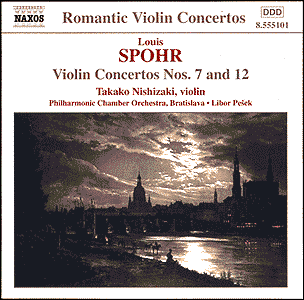|
Louis SPOHR (1784-1859) Crotchet AmazonUK AmazonUS Amazon recommendations |
 |
Louis Spohr was born in North Germany, the son of a doctor, and showed great talent for the violin from an early age, joining a ducal orchestra when fifteen. Supported by the Duke, he undertook tours and when 20 and won overnight fame when he played at a Leipzig concert. In 1802 Spohr became a pupil of the Mannheim violinist Franz Eck, a musician whose father had worked with Mozart. Eck toured with the young Spohr as far as Russia where Eck became court violinist. Spohr then travelled as a virtuoso giving concerts with his harpist wife and developing his abilities as a composer.
His career took off when he became leader of a Vienna theatre orchestra and, later, opera director at Frankfurt and Kassel. He undertook many international virtuoso concert tours and conducted numerous music festivals. Spohr was particularly impressed by Mozart and he was a friend of Beethoven.
The Violin Concerto No. 7 in E Minor is among the most characteristic of Spohr's works with a dramatic, classical form and providing a vehicle for displaying the technical possibilities of violin virtuosity. An Allegro opens the work with an orchestral exposition introducing the thematic material. A leisurely Adagio provides an emotive lyrical subject with interesting shifts of key. The Rondo provides an opportunity for the soloist (and composer) to prove mastery of the violin and in this respect Nishizaki does full justice to the technical requirements of the movement.
The Violin Concerto No. 12 in A Minor has its movements linked (Andante grave - Largetto con moto - Alla polacca) These flow without any break. The work is operatic in style. A horn chord motif at the beginning regularly punctuates the first movement and the strings introduce a long sentimental passage with strong melody. A touch of anguish then unfolds a main subject of sympathetic romanticism before flowing into a much lighter tripping balletic subject, reminiscent of Mendelssohn or Tchaikovsky. This is a strongly virtuoso concertino, delicately played by Nishizaki with tender passion.
Takako Nishizaki is a particularly experienced and accomplished player: she provides a sumptuous performance of the two works. It should be mentioned that her father was co-founder of the Suzuki Method and Takako was in fact one of the first students to complete a Suzuki course. She has a close association with Naxos and has made other Marco Polo/Naxos recordings, [a good interpretation of the Rubinstein Violin Concerto, Op. 46 & Cui Suite Concertante, Op. 25 found on Naxos 8.555244].
In this recording there is a good balance between the forwardly-placed soloist and the orchestra. Pesek's reading of the scores is sensitive and well accomplished.
There is nothing wrong with the light orchestral reverberation used in this recording, but at times the violin reverberation seems to have been artificially exaggerated giving a harshness of tone in solo passages.
Raymond Walker